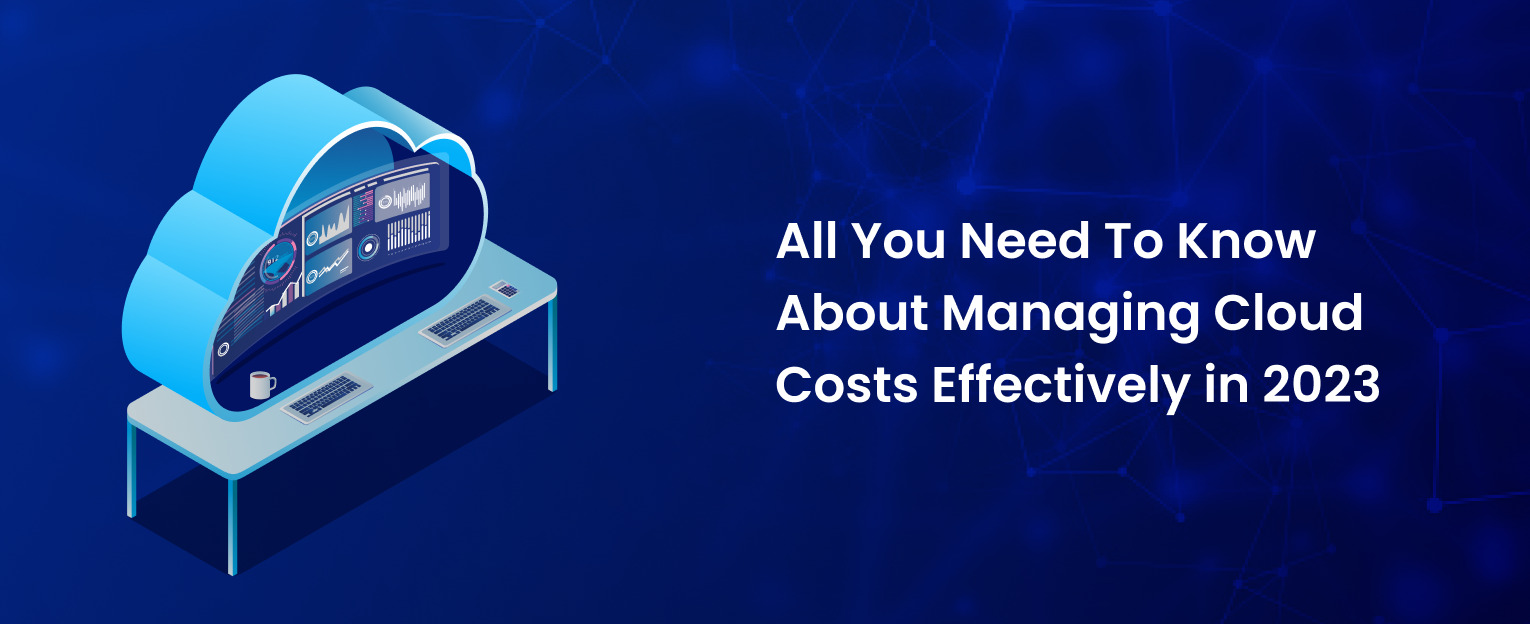With the increasing demand for cloud services, organizations have to optimize their AWS costs for maximum profitability. Achieving a competitive edge in today’s fast-paced market seems impossible with this issue. That’s where AWS cost optimization comes in!
It ensures businesses reach their full potential by effectively managing costs for them.
What Is AWS Cost Optimization?
AWS Cost Optimization refers to reducing and regulating your Amazon Web Services to ensure you get maximum value from each dollar invested. This approach guarantees that your AWS services usage and expenses are aligned with your unique business requirements.
For businesses, the significance of this initiative is two fold. First, it ensures efficient use of resources, preventing wasteful spending. Second, it facilitates budget control, allowing for accurate financial forecasting.
Thankfully, AWS provides a range of services and features to empower businesses in cost management. However, with the constantly evolving landscape of cloud technology, keeping up with the latest cost optimization AWS techniques and strategies can be quite challenging. This is where AWS cost optimization tools come into play.
Top Tools for Streamlining AWS Costs in Business Operations
AWS cost optimization tools can work miracles for businesses. They streamline operations, boost financial efficiency, and give enterprises a competitive edge. They also help you thrive in competitive markets. With these tools in hand, savings become a reality for your business. Let’s take a look at the top 5 tools for AWS cost optimization:
AWS Budgets
AWS Budgets is a fundamental tool for businesses to control their AWS costs effectively. With this cost optimization tool, you can set custom cost and usage budgets that alert you when you exceed predefined thresholds. This proactive approach empowers businesses to stay on top of expenses, fostering financial discipline and preventing unexpected overruns.
AWS Budgets provides clear visibility into spending patterns, enabling timely adjustments to align with budgetary constraints. You can also set up notifications to monitor various cost objects, such as an entire AWS account, service, or resource group. This way, you can quickly respond to significant changes in utilization and take corrective action before it’s too late.
AWS Cost Explorer
AWS Cost Explorer is a powerful analytics tool that grants you deep insights into your AWS usage and costs. You can easily visualize, comprehend, and effectively manage your expenses over time. With its intuitive interface, AWS Cost Explorer makes it easy to create custom reports and analyze your data in various dimensions.
You can also forecast future costs based on your historical usage, giving you better control over your budget planning. The tool’s granular filtering capabilities allow you to drill down into specific services, regions, or tags, further enhancing cost visibility. This level of transparency enables you to identify areas of overspending and take necessary corrective actions.
AWS Pricing Calculator
The AWS Pricing Calculator is an indispensable tool for businesses seeking cost predictability. It enables you to estimate your monthly AWS bill based on specific services, usage patterns, and configurations. This tool aids in planning and budgeting by providing cost estimates for various scenarios, helping businesses make informed decisions about resource allocation.
Additionally, the AWS Pricing Calculator helps you optimize costs by recommending cost-effective resources based on your usage requirements. It also highlights potential areas of overspending, allowing you to adjust your configurations for optimal resource utilization.
AWS CloudWatch
AWS CloudWatch optimizes AWS costs by providing comprehensive monitoring and management of resources. It allows businesses to collect and track metrics, gain insights into application performance, and respond dynamically to changing resource demands.
With AWS CloudWatch, businesses can identify and utilize their resources, enhance application performance, and implement scalable strategies. This AWS cost optimization tool not only reduces costs but also improves operational efficiency, resulting in a more streamlined and effective operation.
AWS Trusted Advisor
AWS Trusted Advisor is a valuable tool that offers personalized recommendations to optimize AWS infrastructure. It assesses an organization’s environment based on best practices, security, and cost optimization.
Trusted Advisor provides actionable insights, highlighting areas for improvement to enhance system performance and reduce unnecessary expenses. It also identifies opportunities for savings, such as eliminating idle resources or resizing underutilized instances. This enables businesses to optimize their AWS costs and ensure their infrastructure aligns with AWS best practices.
AWS Cost Optimization Best Practices
Practice 1: Right-Sizing Resources
Right-sizing resources is foundational to optimize AWS costs. Evaluate your instance types to match actual performance needs, ensuring you’re not overprovisioning. Regularly assess and adjust resources to accommodate changing workloads. This practice helps eliminate unnecessary expenses and enhances operational efficiency.
One way to right-size resources is by using AWS Trusted Advisor. This tool provides recommendations on how to optimize your resources and reduce costs, including identifying idle or underutilized EC2 instances and recommending the most cost-effective instance types for your workload.
Practice 2: Leverage Reserved Instances (RIs)
Utilize Reserved Instances for predictable workloads. RIs offer significant cost savings compared to On-Demand pricing. Strategic planning and commitment to RIs for stable workloads can lead to substantial long-term savings, enabling businesses to optimize resource allocation for maximum effectiveness.
AWS provides several types of RIs, such as Standard, Convertible, and Scheduled, each with different pricing models to suit various use cases. Properly utilizing RIs can result in up to 75% cost savings.

Ready to Optimize Your AWS Costs?
Unlock potential savings and propel your business growth with personalized AWS cost optimization strategies tailored to your needs. Schedule a consultation with our experts today.
Practice 3: Implement Tagging for Resources
Tagging resources with relevant metadata enables precise tracking and allocation of costs. This practice enhances visibility into spending patterns, making it easier to identify and manage expenses associated with specific projects or departments.
Consistent tagging streamlines financial accountability and promotes a transparent cost structure. AWS offers tagging capabilities through its services, allowing businesses to trace resource costs and estimate future expenses accurately.
Practice 4: Set Up Budgets and Alerts
Establishing AWS Budgets and associated alerts is important for cost control. Define spending thresholds and receive notifications when nearing or exceeding these limits. This proactive approach enables timely intervention, preventing unexpected cost spikes and fostering financial discipline within the organization.
AWS Budgets also provide cost and usage forecasts, allowing businesses to plan for future expenses accurately. This helps in optimizing resource allocation and avoiding excessive spending.
Practice 5: Utilize Spot Instances Strategically
Take initiative in AWS Spot Instances for flexible, cost-effective computing. These instances allow you to use spare AWS capacity at a lower price. While not suitable for all workloads, strategically incorporating Spot Instances can lead to significant cost savings, especially for fault-tolerant and time-flexible applications.
Spot Instances also come with various purchasing options, such as Spot Blocks, which provide more stability and predictability for longer-running workloads. This practice allows businesses to leverage unused capacity while keeping costs low.
Practice 6: Regularly Review and Adjust Strategies
Regularly reviewing and adjusting AWS cost optimization strategies based on evolving business needs and technology advancements is key to successful cost management. AWS offers various tools and services, such as Cost Explorer, to analyze spending patterns and identify opportunities for optimization.
Stay informed about new AWS services and pricing models to make sure your cost optimization efforts align with the latest offerings, features, and best practices.
Practice 7: Optimize Data Storage Costs
Efficiently manage data storage by selecting appropriate storage classes based on access frequency and performance requirements. Implement data lifecycle policies to automatically transition or expire data as needed. This practice ensures optimal use of storage resources while minimizing associated costs.
AWS has various storage classes, such as Amazon S3 Standard, Glacier, and Intelligent Tiering, each with different pricing models. By understanding your data access patterns and choosing the most suitable storage class for each use case, you can optimize data storage costs significantly.
Practice 8: Enable Auto Scaling
Implement Auto Scaling to dynamically adjust resources based on demand. This automated approach confirms optimal performance during peak times and resource conservation during periods of lower demand. Auto Scaling helps maintain efficiency and responsiveness while controlling costs in a dynamic environment.
AWS offers various Auto Scaling options, such as scaling based on a schedule or predefined thresholds. This practice allows businesses to optimize resource utilization and costs without manual intervention.
Practice 9: Explore AWS Cost and Usage Reports
Employ AWS Cost and Usage Reports for detailed insights into spending patterns. These reports provide comprehensive data on usage, costs, and Reserved Instance utilization. Analyzing these reports empowers businesses to make informed decisions, identify trends, and further refine cost optimization strategies.
Customize reports to suit your specific needs and schedule them for regular delivery. This practice enables businesses to stay on top of their AWS costs and make adjustments as needed.
Practice 10: Utilize AWS Savings Plans
Explore AWS Savings Plans as a flexible pricing model that offers significant savings over On-Demand pricing. Savings plans provide cost predictability, making them suitable for a variety of workloads. Evaluate and adopt Savings Plans based on your organization’s specific utilization patterns for long-term cost efficiency.
AWS provides a variety of options for different needs and requirements, such as Compute and EC2 Instance plans, providing flexibility in optimizing costs across various services. This practice allows businesses to realize savings while enjoying the benefits of Reserved Instances.
Practice 11: Optimize Network Costs
Efficiently manage network costs by selecting appropriate data transfer options and optimizing data flows. Utilize content delivery networks (CDNs) to reduce latency and data transfer costs. Strategic network optimization ensures efficient communication between resources while minimizing associated expenses.
AWS provides a multitude of networking choices, such as Amazon CloudFront for CDNs and AWS Global Accelerator for optimized data transfer. By leveraging these services and optimizing network traffic, businesses can achieve significant cost savings in their AWS usage.
Practice 12: Embrace Serverless Architectures
Embrace serverless architectures to eliminate the need for managing infrastructure. Serverless computing allows you to pay only for the actual computing time used, and minimize idle resource costs. This approach fosters agility, scalability, and cost efficiency for applications with variable workloads.
AWS has various serverless services, such as AWS Lambda and Amazon API Gateway. By leveraging these services, businesses can reduce overall costs while enjoying the benefits of efficient and scalable architectures.
Practice 13: Evaluate and Decommission Unused Resources
Regularly auditing your AWS environment to identify and decommission unused or underutilized resources is a great practice. This proactive cleanup minimizes costs associated with maintaining unnecessary infrastructure, promoting a lean and cost-effective cloud environment.
AWS offers tools, such as AWS Trusted Advisor, to identify resources that are no longer needed or have security vulnerabilities. This practice helps keep costs under control by eliminating unnecessary expenses.
Practice 14: Collaborate Across Teams for Cost Awareness
Promote a culture of cost awareness across teams by allowing collaboration between IT, finance, and development. Encourage regular communication on cost-related matters, share best practices, and align financial goals with technical strategies. This collaborative approach enhances overall cost optimization efforts.
AWS provides various tools and services, such as AWS Budgets, to facilitate cross-team collaboration and cost management. By breaking down silos and promoting a culture of cost awareness, businesses can achieve significant savings while delivering value to their customers.
Pillars of AWS Cost Optimization for Your Business
AWS Cost Optimization is essential for businesses seeking efficiency and financial caution in their cloud operations. The five pillars of AWS Cost Optimization constitute a comprehensive framework, encompassing strategies and best practices to maximize cost-effectiveness while leveraging the AWS cloud infrastructure. Here are the top five pillars of cost optimization in AWS:
Strategic Savings Plans
AWS Savings Plans emerge as a fundamental component in the AWS cost optimization framework. They offer businesses flexibility and significant cost reductions, providing a balance between savings and commitment. By adopting Savings Plans, organizations achieve cost predictability, ensuring optimal resource allocation for various workloads while minimizing overall expenses.
Right-Sizing as the Foundation
This AWS cost optimization pillar emphasizes right-sizing to align resources with actual workload requirements. By selecting instances of the right sizes, businesses can avoid overprovisioning and optimize both performance and costs. This practice ensures that computing resources scale efficiently with demand, preventing unnecessary expenses.
Embracing Cloud-Native Architectures
The AWS framework for cost optimization emphasizes the adoption of cloud-native architectures as a strategic pillar. By embracing serverless computing and containerization, businesses eliminate the need for traditional infrastructure management. This approach not only reduces idle resource costs but also enhances agility and scalability, aligning with modern cloud paradigms.
Utilizing Reserved Instances for Stability
Reserved Instances (RIs) are a key pillar in AWS cloud cost optimization. By committing to RIs for predictable workloads, businesses benefit from substantial cost savings compared to On-Demand pricing. This strategic approach provides stability in cost planning, allowing organizations to allocate resources effectively and enhance long-term financial predictability.
Spot Instances for Flexibility
Flexibility is central to the AWS cost optimization pillar, and the use of Spot Instances exemplifies this principle. Spot Instances allow businesses to access spare AWS capacity at lower costs, offering an economical alternative for fault-tolerant and time-flexible applications. This dynamic approach optimizes costs while ensuring flexibility in resource utilization.
These five pillars collectively form a robust foundation for AWS cost optimization, enabling businesses to strike a balance between performance, flexibility, and responsibility. Implementing these strategies aligns with industry best practices and enables a cost-conscious organizational culture.

Ready to Build Your Cost-Saving Foundation?
Unlock the power of AWS cost optimization with our tailored solutions. Take the first step towards sustainable growth. Schedule your consultation now.
Ready to Optimize AWS Costs for Business Growth?
AWS cost optimization is not just a strategy but an ongoing process that empowers businesses to leverage the AWS Cloud’s agility, innovation, and financial benefits. The best practices and pillars of cost optimization with AWS laid out in this blog act as a comprehensive blueprint for you to streamline costs while maximizing efficiency.
By implementing these practices, you can align your financial goals with your technical strategies, paving the way for sustainable growth. Now is the time to embark on your AWS cost optimization journey and unlock the full potential of the AWS Cloud. And how can you do it?
You can partner up with an experienced and trusted AWS cloud partner to guide you through this process and ensure you realize the actual value and savings that AWS offers.
- Frequently Asked Questions
Q1. What Is Optimization in AWS?
In AWS, optimization refers to strategically managing resources and services to enhance efficiency, performance, and cost-effectiveness.
Q2. What Is the Key Service for Cost Optimization in AWS?
AWS offers several services for cost optimization, but a critical tool is AWS Cost Explorer. It provides in-depth insights into usage patterns and cost drivers and allows users to visualize, understand, and optimize their AWS spending.
Q3.What Is AWS Cost Reduction Strategy?
AWS cost reduction strategy is the process of adopting various practices to minimize expenses while maximizing the value of cloud resources. The strategy aims to align costs with actual usage and optimize resource utilization.
Q4. Which AWS Services Can Assist You With Cost Optimization?
Several AWS services play a significant role in optimizing costs. These include AWS Cost Explorer, AWS Budgets, AWS Trusted Advisor, AWS Pricing Calculator, and AWS CloudWatch.







